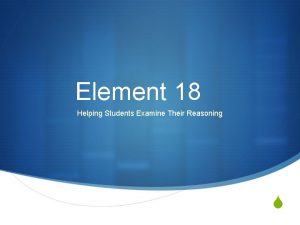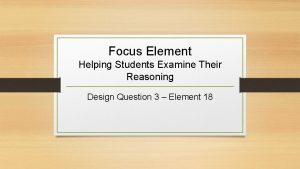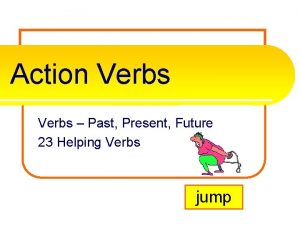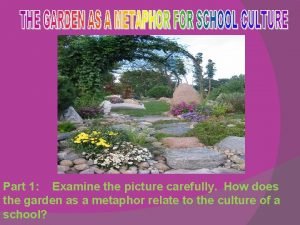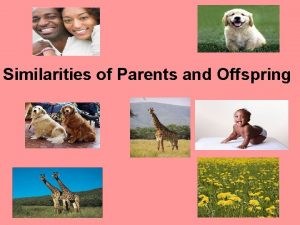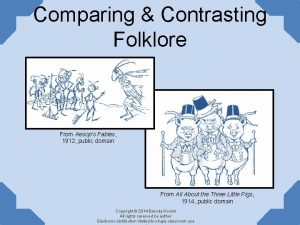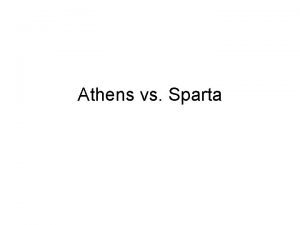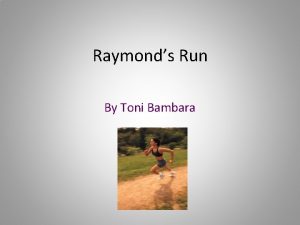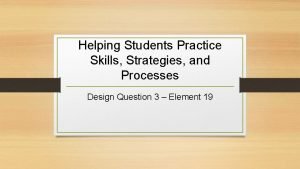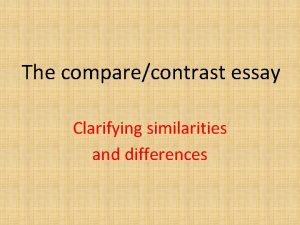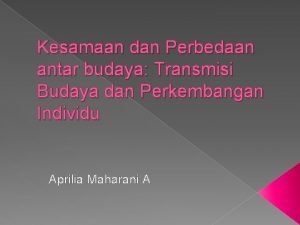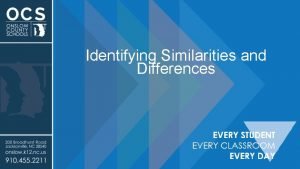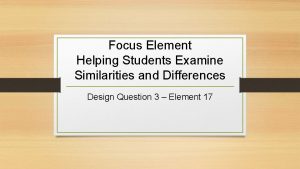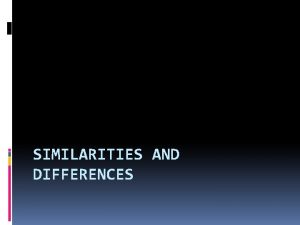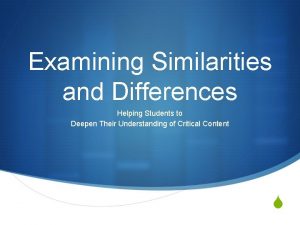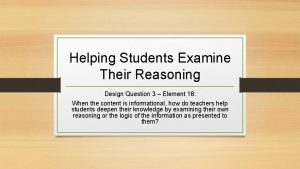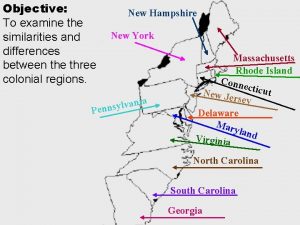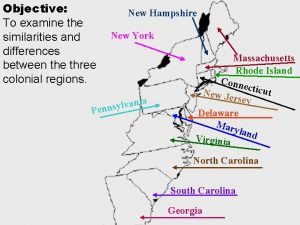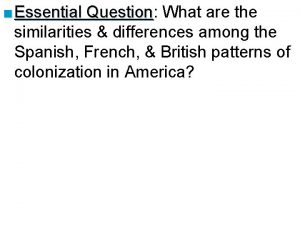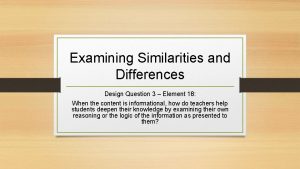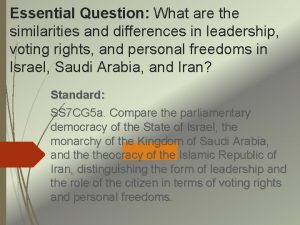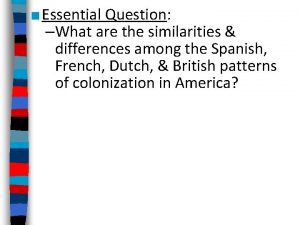Helping Students Examine Similarities and Differences Design Question














- Slides: 14

Helping Students Examine Similarities and Differences Design Question 3 – Element 17: How do teachers help students deepen their knowledge by examining similarities and differences?

Before we begin… Before we begin talking about element 17, let’s be sure that there is an understanding about how the elements in Design Question 2 relate to Design Question 3. This is important as you plan your lessons. Watch the video on the next slide. Please identify the difference between the purpose of Design Question 2 and Design Question 3.

How is Design Question 3 different from Design Question 2? Introduction to Design Question 3 DSBPCPro. Development. "Introduction to Design Question 3. " You. Tube, 17 Jan. 2014. Web. 10 Mar. 2016.

How is Design Question 3 different from Design Question 2? You should have noticed: • The purpose of Design Question 2 is to introduce new material to students while • The purpose of Design Question 3 is to give the students an opportunity to practice using material that was previously taught so that they deepen their understanding; therefore, • Teachers have to perform Design Question 2 before Design Question 3. Now let’s talk about element 17, specifically. DSBPCPro. Development. "Introduction to Design Question 3. " You. Tube, 17 Jan. 2014. Web. 10 Mar. 2016.

Review Teacher and Student Evidence NOTE: This list of evidence is not all inclusive but is instead a list of possible examples.

Review Scale for Element 17

Desired Effect in the Students The desired effect is, “Students describe how elements are similar and different and what new information they have learned as a result of their comparisons. ” To receive an innovating rating, the teacher must adapt and create new strategies for unique student needs and situations in order for the desired effect to be evident in ALL students. In other words, the teacher must make necessary accommodations to ensure every student has the opportunity to compare elements and describe what they have learned by completing the comparisons.

Before watching the video, think about… • How do you engage students in activities (e. g. comparison, classifying, analogy, etc. . ) that require them to examine similarities related to content?

Examples of Element 17: Helping Students Examine Similarities and Differences – Grade 2 Compare and Contrast Strategy in the Classroom – Grade 5 Similarities and Differences – Grade 3 Thoughtful Classroom. "Compare and Contrast Strategy in a Classroom. "You. Tube, 17 Mar. 2010. Web. 10 Mar. 2016 Ways 2 learn. "Similarities & Differences Elementary 1. " You. Tube, 19 Oct. 2012. Web. 10 Mar. 2016.

Now that you have watched the video, reflect… • To achieve an applying rating, how might you monitor to the extent to which students are deepening their knowledge? • To achieve an innovating rating, how will you adapt and create new strategies for helping ALL students deepen their knowledge by examining similarities and differences?

Other Resources Not Found in i. Observation 1. 2. 3. 4. Four basic types of tasks to examine similarities and differences Specific activities for identifying similarities and differences. Freeology. com – Graphic organizers Identifying Similarities & Difference Nonlinguistic Representation Power. Point Platte-Geddes School District in South Dakota

Remember… • When planning lessons, look for topics that allow for extended comparisons. • Model how to create and use comparisons, classifications, similes, metaphors, and analogies. • Ask students to explain and justify their reasoning. • Ask students to revise their comparisons and classifications after discussing them with peers. 17. Helping Students Examine Similarities and Differences: Marzano Instructional Framework Resources. Pasco County Schools, 23 Feb. 2016. Web. 10 Mar. 2016.

Is this element in your PGP? 1. Sign into www. effectiveeducators. com. 1. Click on the Growth tab 2. Click on the Plans option. 3. Open your current plan and fill out a new Reflection Log, answering the appropriate questions. 2. Decide how you will change your teaching as a result of viewing this module. 3. Execute your change, reflect on its impact, and complete another Reflection Log in i. Observation.

How Are You Supported? Here are resources in case you have further questions: - Your evaluator Another evaluator on your campus Your school’s Classroom Practice Mentors (CPM) For more examples and resources visit the All About Marzano website - Everything you ever wanted to know (and more) Helping Students Examine Similarities and Differences
 Marzano element 18
Marzano element 18 Helping students examine their reasoning
Helping students examine their reasoning Action verbs past present future tense
Action verbs past present future tense Examine the picture carefully
Examine the picture carefully Similarities between parents and offspring
Similarities between parents and offspring Why are the domain of ppst necessary in the curriculum?
Why are the domain of ppst necessary in the curriculum? The ant and the grasshopper plot diagram
The ant and the grasshopper plot diagram Compare sparta and athens
Compare sparta and athens What is the tone of raymond's run
What is the tone of raymond's run Compare and contrast wid and wad
Compare and contrast wid and wad Marzano element 19
Marzano element 19 Costa levels
Costa levels Compare definition
Compare definition Cross cultural differences and similarities
Cross cultural differences and similarities Identifying similarities and differences
Identifying similarities and differences
